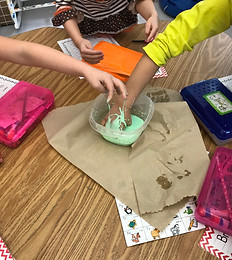Science


Severe Weather
During our weather unit, I spent a day on three types of severe weather: hurricanes, tornadoes, and blizzards. The students had to draw a prediction of what they thought the three types of weather looked like, and I called on a few students to share their predictions. After our predictions, we did three experiments: hurricane in a bowl, tornado in a bottle, and blizzard in a jar. I had the students come up and help me with the experiments. After each experiment, the students went back to their seats and drew their observations. We would talk about each type of weather and circle the characteristics of each type, which allowed me to assess the students. Once the experiments were finished, I showed the students a video to show them what a hurricane, tornado, and blizzard looked like in real life. The students were very engaged during this activity. They enjoyed being scientists, while also surviving a hurricane, tornado, and a blizzard.

Bartholomew's Oobleck


During Read Across America Week, the students did many Dr. Seuss themed activities. One of the activities involved experimenting with the oobleck from Bartholomew and the Oobleck. The students had to determine if everyday objects, such as a penny, paperclip, bottle cap, toothpick and dice, would sink or float in the sticky oobleck. They listened to a condensed version of Bartholomew and the Oobleck by Dr. Seuss, so they knew the story behind the oobleck. Before making their predictions, the students were able to play with the oobleck to see what it felt like. Then, they used the activity sheet to make predictions on whether each object would sink or float. Each student was given an object to drop into their groups' oobleck. After each object was dropped, the students would have to circle their observation. The students thought that this activity was very fun. They were amazed by the oobleck and how some things would sink but other things would float. At the end, one student made a very important observation: that the lighter objects would float and the heavier objects would sink.